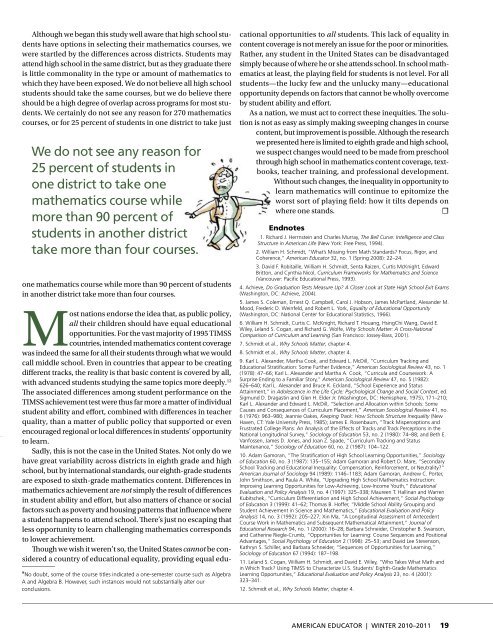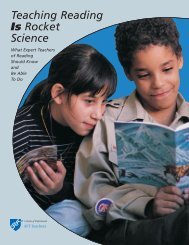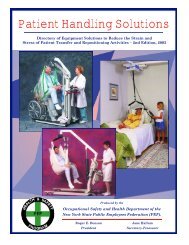American Educator, Winter 2010-11, Vol. 34, No. 4, AFT
American Educator, Winter 2010-11, Vol. 34, No. 4, AFT
American Educator, Winter 2010-11, Vol. 34, No. 4, AFT
You also want an ePaper? Increase the reach of your titles
YUMPU automatically turns print PDFs into web optimized ePapers that Google loves.
Although we began this study well aware that high school students<br />
have options in selecting their mathematics courses, we<br />
were startled by the diff erences across districts. Students may<br />
attend high school in the same district, but as they graduate there<br />
is little commonality in the type or amount of mathematics to<br />
which they have been exposed. We do not believe all high school<br />
students should take the same courses, but we do believe there<br />
should be a high degree of overlap across programs for most students.<br />
We certainly do not see any reason for 270 mathematics<br />
courses, or for 25 percent of students in one district to take just<br />
We do not see any reason for<br />
25 percent of students in<br />
one district to take one<br />
mathematics course while<br />
more than 90 percent of<br />
students in another district<br />
take more than four courses.<br />
one mathematics course while more than 90 percent of students<br />
in another district take more than four courses.<br />
Most nations endorse the idea that, as public policy,<br />
all their children should have equal educational<br />
opportunities. For the vast majority of 1995 TIMSS<br />
countries, intended mathematics content coverage<br />
was indeed the same for all their students through what we would<br />
call middle school. Even in countries that appear to be creating<br />
diff erent tracks, the reality is that basic content is covered by all,<br />
with advanced students studying the same topics more deeply. 12<br />
Th e associated diff erences among student performance on the<br />
TIMSS achievement test were thus far more a matter of individual<br />
student ability and eff ort, combined with diff erences in teacher<br />
quality, than a matter of public policy that supported or even<br />
encouraged regional or local diff erences in students’ opportunity<br />
to learn.<br />
Sadly, this is not the case in the United States. <strong>No</strong>t only do we<br />
have great variability across districts in eighth grade and high<br />
school, but by international standards, our eighth-grade students<br />
are exposed to sixth-grade mathematics content. Diff erences in<br />
mathematics achievement are not simply the result of diff erences<br />
in student ability and eff ort, but also matters of chance or social<br />
factors such as poverty and housing patterns that infl uence where<br />
a student happens to attend school. Th ere’s just no escaping that<br />
less opportunity to learn challenging mathematics corresponds<br />
to lower achievement.<br />
Th ough we wish it weren’t so, the United States cannot be considered<br />
a country of educational equality, providing equal edu-<br />
*<strong>No</strong> doubt, some of the course titles indicated a one-semester course such as Algebra<br />
A and Algebra B. However, such instances would not substantially alter our<br />
conclusions.<br />
cational opportunities to all students. This lack of equality in<br />
content coverage is not merely an issue for the poor or minorities.<br />
Rather, any student in the United States can be disadvantaged<br />
simply because of where he or she attends school. In school mathematics<br />
at least, the playing fi eld for students is not level. For all<br />
students—the lucky few and the unlucky many—educational<br />
opportunity depends on factors that cannot be wholly overcome<br />
by student ability and eff ort.<br />
As a nation, we must act to correct these inequities. Th e solution<br />
is not as easy as simply making sweeping changes in course<br />
content, but improvement is possible. Although the research<br />
we presented here is limited to eighth grade and high school,<br />
we suspect changes would need to be made from preschool<br />
through high school in mathematics content coverage, textbooks,<br />
teacher training, and professional development.<br />
Without such changes, the inequality in opportunity to<br />
learn mathematics will continue to epitomize the<br />
worst sort of playing field: how it tilts depends on<br />
where one stands. ☐<br />
Endnotes<br />
1. Richard J. Herrnstein and Charles Murray, The Bell Curve: Intelligence and Class<br />
Structure in <strong>American</strong> Life (New York: Free Press, 1994).<br />
2. William H. Schmidt, “What’s Missing from Math Standards? Focus, Rigor, and<br />
Coherence,” <strong>American</strong> <strong>Educator</strong> 32, no. 1 (Spring 2008): 22–24.<br />
3. David F. Robitaille, William H. Schmidt, Senta Raizen, Curtis McKnight, Edward<br />
Britton, and Cynthia Nicol, Curriculum Frameworks for Mathematics and Science<br />
(Vancouver: Pacifi c Educational Press, 1993).<br />
4. Achieve, Do Graduation Tests Measure Up? A Closer Look at State High School Exit Exams<br />
(Washington, DC: Achieve, 2004).<br />
5. James S. Coleman, Ernest Q. Campbell, Carol J. Hobson, James McPartland, Alexander M.<br />
Mood, Frederic D. Weinfeld, and Robert L. York, Equality of Educational Opportunity<br />
(Washington, DC: National Center for Educational Statistics, 1966).<br />
6. William H. Schmidt, Curtis C. McKnight, Richard T. Houang, HsingChi Wang, David E.<br />
Wiley, Leland S. Cogan, and Richard G. Wolfe, Why Schools Matter: A Cross-National<br />
Comparison of Curriculum and Learning (San Francisco: Jossey-Bass, 2001).<br />
7. Schmidt et al., Why Schools Matter, chapter 4.<br />
8. Schmidt et al., Why Schools Matter, chapter 4.<br />
9. Karl L. Alexander, Martha Cook, and Edward L. McDill, “Curriculum Tracking and<br />
Educational Stratifi cation: Some Further Evidence,” <strong>American</strong> Sociological Review 43, no. 1<br />
(1978): 47–66; Karl L. Alexander and Martha A. Cook, “Curricula and Coursework: A<br />
Surprise Ending to a Familiar Story,” <strong>American</strong> Sociological Review 47, no. 5 (1982):<br />
626–640; Karl L. Alexander and Bruce K. Eckland, “School Experience and Status<br />
Attainment,” in Adolescence in the Life Cycle: Psychological Change and Social Context, ed.<br />
Sigmund D. Dragastin and Glen H. Elder Jr. (Washington, DC: Hemisphere, 1975), 171–210;<br />
Karl L. Alexander and Edward L. McDill, “Selection and Allocation within Schools: Some<br />
Causes and Consequences of Curriculum Placement,” <strong>American</strong> Sociological Review 41, no.<br />
6 (1976): 963–980; Jeannie Oakes, Keeping Track: How Schools Structure Inequality (New<br />
Haven, CT: Yale University Press, 1985); James E. Rosenbaum, “Track Misperceptions and<br />
Frustrated College Plans: An Analysis of the Effects of Tracks and Track Perceptions in the<br />
National Longitudinal Survey,” Sociology of Education 53, no. 2 (1980): 74–88; and Beth E.<br />
Vanfossen, James D. Jones, and Joan Z. Spade, “Curriculum Tracking and Status<br />
Maintenance,” Sociology of Education 60, no. 2 (1987): 104–122.<br />
10. Adam Gamoran, “The Stratifi cation of High School Learning Opportunities,” Sociology<br />
of Education 60, no. 3 (1987): 135–155; Adam Gamoran and Robert D. Mare, “Secondary<br />
School Tracking and Educational Inequality: Compensation, Reinforcement, or Neutrality?”<br />
<strong>American</strong> Journal of Sociology 94 (1989): <strong>11</strong>46–<strong>11</strong>83; Adam Gamoran, Andrew C. Porter,<br />
John Smithson, and Paula A. White, “Upgrading High School Mathematics Instruction:<br />
Improving Learning Opportunities for Low-Achieving, Low-Income Youth,” Educational<br />
Evaluation and Policy Analysis 19, no. 4 (1997): 325–338; Maureen T. Hallinan and Warren<br />
Kubitschek, “Curriculum Differentiation and High School Achievement,” Social Psychology<br />
of Education 3 (1999): 41–62; Thomas B. Hoffer, “Middle School Ability Grouping and<br />
Student Achievement in Science and Mathematics,” Educational Evaluation and Policy<br />
Analysis 14, no. 3 (1992): 205–227; Xin Ma, “A Longitudinal Assessment of Antecedent<br />
Course Work in Mathematics and Subsequent Mathematical Attainment,” Journal of<br />
Educational Research 94, no. 1 (2000): 16–28; Barbara Schneider, Christopher B. Swanson,<br />
and Catherine Riegle-Crumb, “Opportunities for Learning: Course Sequences and Positional<br />
Advantages,” Social Psychology of Education 2 (1998): 25–53; and David Lee Stevenson,<br />
Kathryn S. Schiller, and Barbara Schneider, “Sequences of Opportunities for Learning,”<br />
Sociology of Education 67 (1994): 187–198.<br />
<strong>11</strong>. Leland S. Cogan, William H. Schmidt, and David E. Wiley, “Who Takes What Math and<br />
in Which Track? Using TIMSS to Characterize U.S. Students’ Eighth-Grade Mathematics<br />
Learning Opportunities,” Educational Evaluation and Policy Analysis 23, no. 4 (2001):<br />
323–<strong>34</strong>1.<br />
12. Schmidt et al., Why Schools Matter, chapter 4.<br />
AMERICAN EDUCATOR | WINTER <strong>2010</strong>–20<strong>11</strong> 19





